Module 2: Senior Leader Engagement: Facilitator Notes
AHRQ Safety Program for Long-Term Care: HAIs/CAUTI
Slide 1: Module 2: Senior Leader Engagement

Say:
The Senior Leader Engagement module focuses on the role and responsibilities of the senior leader within the facility safety team. Engaging a senior leader will bridge the gap between senior management and frontline providers, and will help to get a system-level perspective on safety challenges that exist. The senior leader chosen should be a senior leader in the facility, either clinical or administrative. Their participation and engagement in the initiative is vital to the success of the project. This module provides information and several tools to encourage senior leaders to participate in the facility's safety initiative.
Slide 2: Objectives

Say:
In this module we will—
- Identify characteristics of successful quality improvement or safety senior leaders.
- List five practices of effective leaders.
- Describe the responsibilities of senior leaders.
- Explain the role of the senior leader in addressing technical and adaptive work and
- Describe how to engage senior leadership in the facility's initiatives and develop shared accountability for the work needed to achieve the facility's safety goals.
Slide 3: What Is Senior Leader Engagement?1

What exactly does senior leader engagement look like? Senior leadership engagement is listening, learning, and partnering with staff to improve resident safety and the quality of health care delivery in the facility. The engaged senior leader works to facilitate progress toward goals and removes identified barriers.
1. Engage the Senior Executive module, CUSP Toolkit. Rockville, MD: Agency for Healthcare Research and Quality.
Slide 4: Why Is Senior Leader Engagement Important?

Say:
The senior leader's involvement in the improvement process validates the work's importance, and it demonstrates that staff will be supported by leadership as they make necessary changes to improve safety. The senior leader also provides accountability needed to achieve the stated goals. This can result in increased staff motivation and buy-in for the necessary changes.
Slide 5: Senior Leadership Characteristics

Say:
For the facility safety team and the project to be most effective, the senior leader should be—
- A senior leader in the facility, either clinical or administrative,
- In the long-term care environment, the senior leader may or may not have a clinical background. The senior leader may be the director of nursing and have clinical experience, or be a nursing home administrator and not have a clinical background.
- Actively engaged,
- Interested in clinical care, and
- Willing to listen, learn, and work with staff to improve patient safety and the quality of health care delivery in the facility.
Executive team members need to be in a high enough position to authorize the use of required resources to help facility safety teams resolve their issues and overcome identified barriers. Senior leaders should be familiar and comfortable with the goals of the project. Senior leaders who have a vested interest in the quality of care make great safety team members.
Slide 6: Models For Leadership2

Say:
There is a difference between what a leader does and how they do it. In order to make sense of these differences, there is a model called the Five Practices of Leadership that is outlined here. This model describes specific behaviors that a leader can do which fulfills each of these five roles.
2. Kouzes JM, Posner BZ. The Leadership Challenge. San Francisco: John Wiley & Sons; 2007.
Slide 7: The Five Practices and Ten Commitments of Leadership2

Say:
Kouzes and Posner emphasize five practices of classic leadership. These practices are not about personality or specific tasks, but focus on behaviors. The senior leadership characteristics on the last slide represent the "what to do", and this slide describes the "how to do it" steps.
- Leaders Model the Way by—
- Clarifying values, openly speaking about what they believe in, and confirming values shared with their team members.
- Setting the example, once team members know what they believe in, leaders have to “walk their talk” and teach others to model these shared values.
- Leaders Inspire a Shared Vision by—
- Picturing where they want the organization to go…what does “The Best We Can Be” look like? Leaders imagine the possibilities and find a common purpose with their teams.
- Enlisting others, inspiring others to join the journey toward organizational excellence, letting their feelings show and using high energy and enthusiasm to motivate others.
- Leaders Challenge the Process by—
- Listening to outside ideas for improving processes, technologies, products, and services (see the Staff Safety Assessment Tool in the CUSP Toolkit) and by using tools to assist in collecting staff input about ways improvements can be successfully implemented.
- Experimenting and taking risks, remaining open to new ideas, encouraging small tests of change to evaluate feasibility of new ideas, working out the kinks in one area before spreading change to the entire facility, encouraging team growth by learning from each setback/defect/error or mistake so that they can be prevented in the future, and celebrating successes.
- Leaders Enable Others To Act by—
- Creating a climate of trust where team members get to know one another by interacting on a personal and professional level, exchanging ideas and solving problems together. Leaders show trust and build trust. They use the word “we,” ask questions, listen, and take advice.
- Strengthening others through coaching to develop competence and confidence, sharing power, and offering visible support.
- Leaders Encourage the Heart by—
- Recognizing contributions of those who demonstrate excellence. This may be a leader stopping by to say a few words of recognition in private or providing an award during a public meeting.
- Celebrating victories as a group reminds team members of their shared values and visions, and helps them feel like they are part of something greater than themselves—that by working as a team they are able to accomplish something that any one of them working alone would not be able to complete.
In essence, these practices and commitments describe leaders who lead by example, involve the whole team, strive for continuous improvement, lift others up, and celebrate the small wins. The colors in the table align the practices with the commitments, and the next slide will align senior leadership roles and responsibilities.
2. Kouzes JM, Posner BZ. The Leadership Challenge. San Francisco: John Wiley & Sons; 2007.
Slide 8: Senior Leader Roles and Responsibilities1,3

Say:
Using the Five Practices and Ten Commitments of Leadership as a framework, the roles and responsibilities of the senior leader aligns with each of these behaviors. The senior leader you engage on this project should—
1. Engage the Senior Executive module, CUSP Toolkit. Rockville, MD: Agency for Healthcare Research and Quality.
3. Bowers N, Nolet K, Roberts, E, et al. Implementing Change in Long-Term Care: A Practical Guide to Transformation. University Wisconsin–Madison, School of Nursing; 2007.
Slide 9: Model the Way

Say:
Leaders Model the Way by—
- Clarifying values, openly speaking about their beliefs, and confirming shared values with their team.
- Setting the example, once team members know what they believe in. Leaders have to “walk their talk” and teach others to model these shared values.
The leader roles and responsibilities for modeling the way include—
Demonstrating improved communication
A leader models the way through transparent communication and outlines clear facility safety goals and expectations. This transparency can include distributing a facilitywide publication, announcing current infection rates at the facility, or encouraging team members to candidly share their concerns. The frequency of these communications should align with the team's needs. Senior leaders have the authority and means to share responsibility for establishing and reinforcing the goals of quality improvement initiatives. They should outline clear expectations for leaders and staff on safety teams. Credibility is the foundation of leadership, and this is established through strong communication with all team members.
Slide 10: Inspire a Shared Vision4

Say:
Leaders Inspire a Shared Vision by—
- Picturing the future. Leaders imagine the possibilities and find a common purpose with their teams.
- Enlisting and inspiring others toward organizational excellence. They use high energy and enthusiasm to motivate others.
- Understanding and supporting the activities that are needed for change.
The leader can inspire a shared vision by aligning the work with other strategic priorities. The senior leader can use their influence to help the team support larger facilitywide projects by motivating and providing encouragement of the team's achievements. This celebrates wins and offers incentive to sustain the initiative. The leader can also demonstrate an understanding that there is both technical and adaptive work to change. See the Examples of Technical and Adaptive Solutions for Change tool that contains additional details concerning the technical and adaptive elements of change.
Ask:
Can you identify any technical solutions to existing problems at your facility? What made the technical solution successful?
Can you identify any adaptive solutions to problems at your facility? What attempts were made to address adaptive challenges?
Slide 11: A Shared Vision

Say:
In the following video, the director of nursing is modeling the way and inspiring a shared vision by explaining the importance of a new infection prevention initiative.
PLAY VIDEO:
Video 2.1: Importance of Infection Prevention
Ask:
Has the importance of the initiative been clearly explained? If you were a member of this team, how would you feel about the project?
Slide 12: Challenge the Process
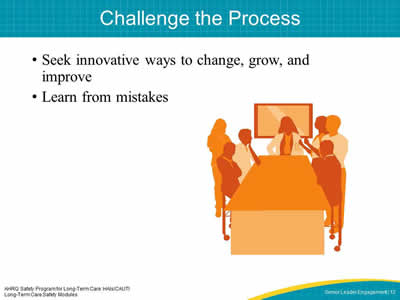
Say:
Leaders Challenge the Process by—
- Searching for opportunities, listening to outside ideas for improving processes, technologies, products, and services (see Staff Safety Assessment Tool-CUSP Toolkit) and by collecting staff input about ways improvements can be successfully implemented.
- Experimenting and taking risks, working out the kinks in one area before spreading change to the entire facility, generating small wins, and encouraging team growth by learning from each mistake.
The leader roles and responsibilities for challenging the process include—
Meeting with the facility team monthly to optimize teamwork
To Challenge the Process, senior leaders need to listen and learn from those around them. They should meet and interact regularly with the other members of the team. They should also join frontline providers and managers for rounds and regular meetings to discuss risk management and project goals. These meetings are a great opportunity to share facility data and discuss facility improvement plans. The senior leader also sets the tone of meetings and rounds, describes values of the organization, and confirms shared ideals. This inspires a shared vision and reinforces the message that safety and effective teamwork are organizational priorities.
These interactions also give the senior leader a chance to better understand the challenges frontline providers face each day, and invite input on how to resolve them, allowing staff to feel supported and heard in their efforts.
Learning from each mistake so they can be prevented in the future
Senior leaders welcome opportunities to learn from setbacks, events or mistakes that happen. They are willing to Challenge the Process if it leads to understanding what happened and how it can be avoided in the future.
Slide 13: Enable the Team

Say:
SAY:
Watch this leader as she encourages each team member, and recognizes their unique role and perspective on the team.
PLAY VIDEO:
Video 2.2: Enabling the Team
Ask:
How has the leader enabled others and encouraged collaboration?
Slide 14: Enable Others To Act
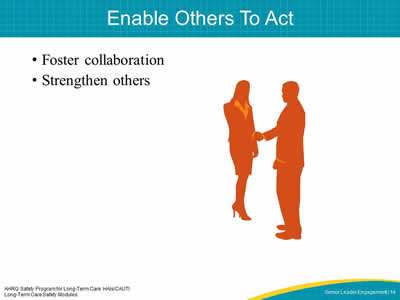
Say:
Leaders Enable Others to Act by—
- Encouraging collaboration and creating a climate of trust. Leaders use the word “we,” ask questions, listen, and take advice.
- Strengthening others to develop competence and confidence, sharing power, and offering visible support for increased individual accountability.
Leaders enable others to act through two key responsibilities:
First, collaborating with others to develop and implement a plan that addresses the safety issues identified by the facility staff, residents, and family members.
The senior leader—
- Shares information about safety risks identified at the system level.
- Involves frontline providers and all team members to help reduce risks, like those who are best able to identify any changes in a resident’s condition such as certified nursing assistants.
- Discusses resident risks identified in the Staff Safety Assessment with team members.
- Helps prioritize hazards and constructs an improvement plan.
- Reviews facility data (for example, the catheter-associated urinary tract infection or CAUTI rate) with the team.
- Provides resources to facilitate all work of the team implementation plan.
- Removes potential barriers (if team is unable to do this independently).
- Offers to talk with those medical care providers not demonstrating compliance with new processes.
The leader's second area of responsibility for enabling others to act is holding all staff accountable for carrying out agreed-upon activities designed to reduce resident harms.
Senior leaders need to hold themselves and staff members accountable for reducing resident risks. Part of this accountability requires that the leader encourages the team to speak up to identify concerns, allowing the team to address them.
As mentioned earlier, the senior leader's ability to allocate resources and use his or her connections are crucial. To help establish his or her role on the facility safety team, the senior leader should try to attend all team meetings and walking rounds, and stay knowledgeable about the current status of the project. They should know how to engage and offer incentives to their team members but also be prepared to address issues regarding compliance and communication as they occur.
Senior leaders should expect and be ready to address resistance to the changes that accompany any resident safety initiative. Senior leaders must be an enthusiastic and visible presence as a part of a facility team. When necessary, senior leaders may utilize Crucial Conversations© communication skills to address individuals who are not supportive of the new process of care.
Slide 15: A Collaborative Effort

Say:
A leader recognizes the importance of a team and everyone's individual contribution to success. Watch this leader encouraging and enabling her team in the project.
PLAY VIDEO:
Video 2.3: A Collaborative Effort
Ask:
How has the leader enabled others and fostered collaboration?
Slide 16: Encourage the Heart
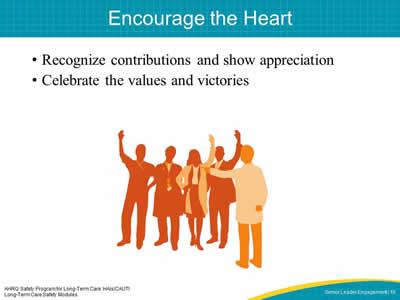
Say:
Leaders Encourage the Heart by—
- Recognizing contributions of those who demonstrate excellence at implementing new processes. This could include a leader stopping by to say a few words of appreciation in private, or providing acknowledgment during a public meeting.
- Celebrating victories publicly reminds team members of their shared values and visions, and creates a sense of community.
The leader roles and responsibilities for encouraging the heart include these two areas:
First, the leader supports the process changes through recognition and reward, especially when goals are met.
Once the facility team has established its goals, the team can work with the senior leader to determine when the project has been successful. If the project is successful, the senior leader can assist in validating that the new process is sustainable, adding it to facility policy, procedure, and protocol.
Second, the leader helps to hardwire the process changes at the facility and communicates the project's success.
An engaged senior leader supports the process changes by recognizing the team's efforts. This includes rewarding the team when progress is made and when a goal is met. The senior leader can also share the results with the facility board and other executive team members.
Slide 17: An Engaged Team Effort
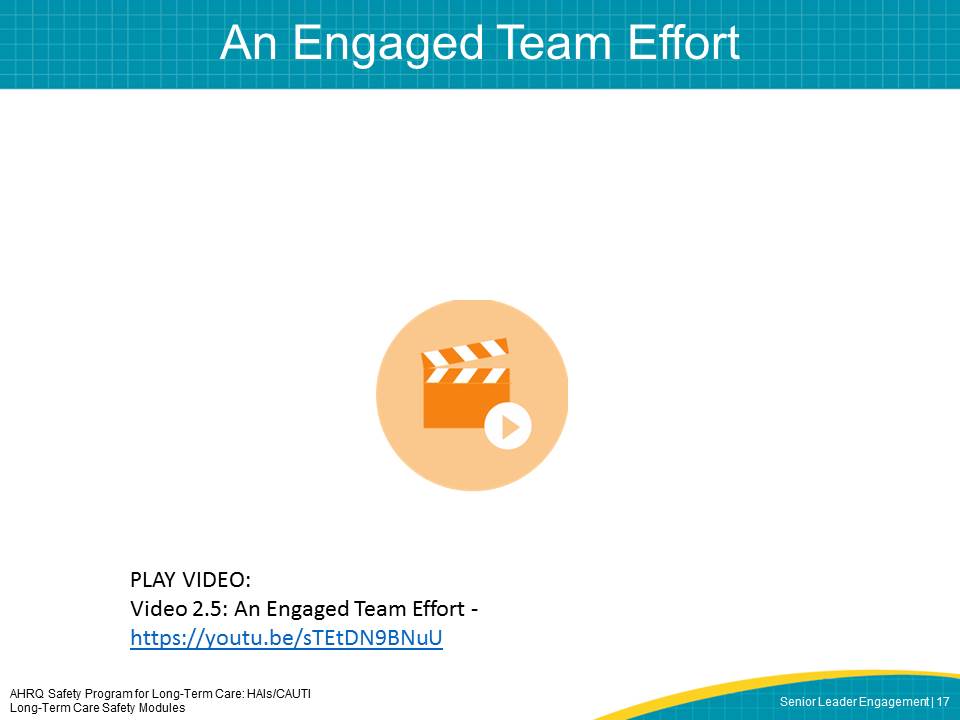
Say:
The following video will demonstrate how an engaged senior leader keeps the team thinking about ideas for the future and how to make the project a success.
PLAY VIDEO:
Video 2.5: An Engaged Team Effort
Ask:
In what ways does the leader model the way? Does she inspire a shared vision and challenge the process? What responsibilities has the leader taken on? Are there senior leaders at your facility who you believe would take on these responsibilities?
Slide 18: Tools for Senior Leaders
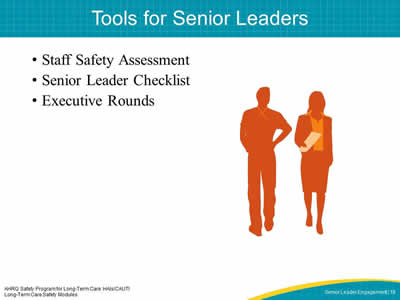
Say:
Many tools can help leaders engage in the project. These include the Staff Safety Assessment, a Senior Leader Checklist, and Executive Rounds.
Slide 19: Staff Safety Assessment Tool
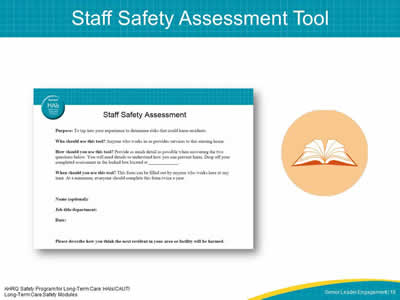
Say:
The Staff Safety Assessment helps the senior leader collaborate with frontline providers to identify and understand possible risks within the facility. Any staff member can complete this assessment, highlighting areas of concern or potential harm that the senior leader can address with the facility team. For more information on the Staff Safety Assessment, see the CUSP Toolkit on the AHRQ Web site.
Slide 20: Senior Leader Checklist Tool
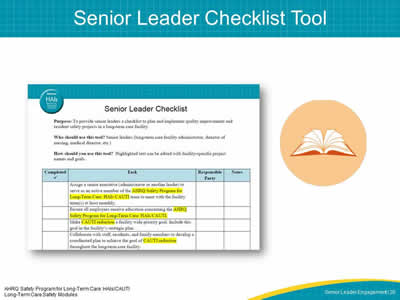
Say:
The Senior Leader Checklist is used to identify high-frequency and/or high-morbidity resident safety concerns. The checklist can be modified to meet the needs of your specific project at the facility.
Note: the image is from CUSP. The checklist will be adapted to be more long-term care specific.
Slide 21: Learn From Defects Tool

Say:
The Learn From Defects tool is used to identify the factors that contributed to the defect (an event or situation that you do not want to happen again) and to plan next steps. This tool can be used by all team members, including senior leaders, to identify ways to learn from an event or situation that you do not want to have happen again.
Slide 22: Executive Rounds6
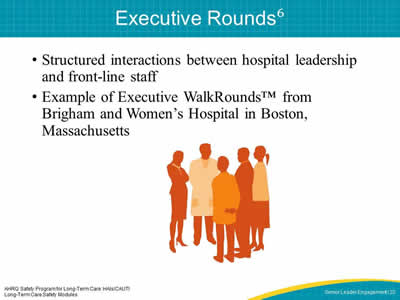
Say:
Executive rounds offer an opportunity for structured interactions between leadership and frontline staff. The rounds can be used to improve communication across the organization, to capture information about high-risk situations that could lead to resident harm, and to respond quickly to risky situations. The rounds also offer an opportunity for senior leadership to increase their visibility and engagement with staff and the project.
As an example, Brigham and Women's Hospital in Boston, MA, has been using structured interactions between hospital leadership and frontline staff—called Executive WalkRounds™—to improve communication across the organization, capture information about high-risk situations that could lead to patient harm, and respond proactively to these situations. These WalkRounds have been directly linked with improvements in organizational attitudes about teamwork and safety.
6. Brigham and Women's Hospital. Other Patient Safety Initiatives - Safety Matters: Executive WalkRounds, Quality of Patient Care. Boston, MA: Brigham and Women's Hospital. Accessed Sept 22, 2014.
Slide 23: How To Engage Your Senior Leader and Develop Shared Accountability
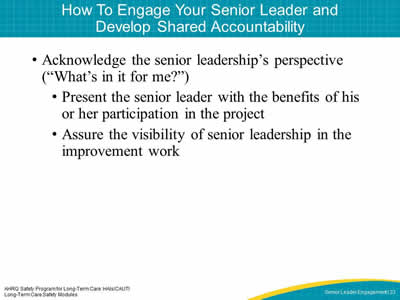
Say:
Just as it is critical to detail the responsibilities of the senior leader, it is equally important for team members to realize how to engage the senior leader while developing shared accountability among the team. This may be difficult to do. Executives and frontline providers serve different roles within the facility. As a result, their interest in and the skills they contribute to the resident safety project will vary greatly.
Keep these things to keep in mind when engaging your senior leader:
Present the senior leader with the benefits of his or her participation in the project. Remember to appeal to his or her interests both in maintaining resident safety and the financial gains that will result from the project. Provide statistics that show the positive effects of the project in reducing resident harm or the average cost per occurrence for the facility.
An easy way to increase the visibility of the facility safety team's senior leader is to post that person's photo and name on a bulletin board. This allows staff to easily identify their senior leader team member. Another way is to ask the senior leader to attend a "get to know you" interview. To accommodate everyone's schedule, one staff member can complete the interview and share the responses with the facility safety team.
This senior leader should meet with the facility safety team regularly and be included in any project-related communications.
Finally, one of the most effective approaches to bridge the gap between senior management and frontline providers is to conduct executive safety rounds. During these rounds, executive team members mingle with staff in the facility while discussing safety issues. The importance of these interactions is twofold. First, facility gatherings offer the senior leader the opportunity to better understand the project and their role within the facility safety team. Second, meeting on the floor also increases senior leader visibility among frontline staff and conveys a stronger commitment to the project. Together as a team, the senior leader and other members can investigate a staff-identified safety issue. This facilitywide interest in resident safety will increase the likelihood of senior leader participation and engagement.
Ask:
What steps can a facility's team leader take to engage their Senior Leader to join the safety team?
Answer: Present the senior leader with the benefits of his or her participation in the project.
Ask:
What do you think those might be?
Answer: Increased resident safety and improved quality of life, improved resident and family satisfaction, improved staff satisfaction and perhaps decreased staff turnover, and visibility of the senior leader in the improvement work.
Ask:
Of the questions above, what might be the most motivating/most successful in obtaining the senior leader's membership?
Slide 24: Engaging your Senior Leader Using the 4 Es for Technical and Adaptive Work5
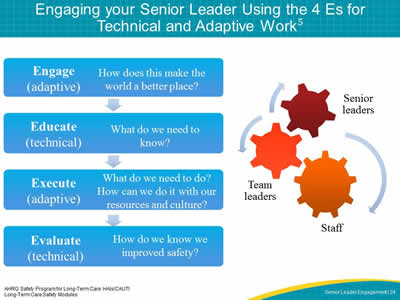
Say:
Use the 4 Es when recruiting a senior leader for the resident safety team. Created by the Johns Hopkins Medicine Armstrong Institute for Patient Safety and Quality, the 4 Es help carry out patient safety interventions by focusing change efforts around technical and adaptive work. This model features four key elements: engage, educate, execute, and evaluate. As part of the facility team, the senior leader actively employs the 4 Es and promotes it as a model for change.
Engage
Within the 4 Es model, you want to engage facility staff in understanding the effects of preventable harm. Engagement is an example of adaptive work, and one way to engage is to share stories about residents affected by this problem and to estimate the number of residents who could be harmed as a result of this problem.
Educate
Education is an example of technical work in which the facility safety team communicates to staff and senior leaders about actions to prevent clinical problems.
Execute
An example of adaptive work, execution is based on the principles of safe system design: Simplify the system, create redundancy, and learn from mistakes.
Evaluate
Evaluation is an example of technical work in which facility safety teams collect and submit data related to any clinical problem to analyze the progress of an intervention.
Leading facilities through change requires team members, including senior leaders, to use both technical and adaptive work to ensure the changes made throughout the project remain in effect even after the project ends.
Ask:
How can you apply the 4 Es to speak with your senior leader?
5. Pronovost PJ, Berenholtz SM, Goeschel CA, et al. Creating high reliability in health care organizations. Health Services Research. 2006;41(4 pt. 2):1599-1617. PMID: 16898981.
Slide 25: Potential Challenges
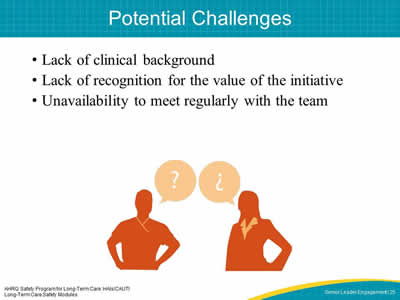
Say:
When engaging the senior leader, you may encounter the following hurdles:
In the long-term care environment, this will be very different depending on whether the director of nursing is the senior leader (clinical background) or if the nursing home administrator is the senior leader (might not have a clinical background). One of the biggest differences here is that the clinical leader may have increased credibility with the clinical staff. There may be multiple levels of administrators or leaders (including staff development coordinator, et cetera). You can work with your facility team to determine which senior leader will be the best fit for your project.
These hurdles are external, and many senior leaders can be effectively engaged with the proper steps. By following the 4 Es, facility safety teams will be able to customize their appeal and project approach to meet the needs and background of the senior leaders, further increasing the success and sustainability of the initiative.
If senior leaders cite their lack of a clinical background, facility safety team members can focus their appeal on the fiscal gains associated with the project. If senior leaders are unable to see the value of the initiative for the facility, team members should share success stories or real data that highlight the triumphs other facility teams have experienced when implementing safety initiatives at their facilities. If senior leaders claim their busy schedules as a barrier to involvement in the project, the facility safety team can arrange monthly meetings via conference calls.
Ask:
What barriers do you foresee to asking a senior leader to serve as a member on your facility safety team?
Slide 26: Tools for Engaging Senior Leadership
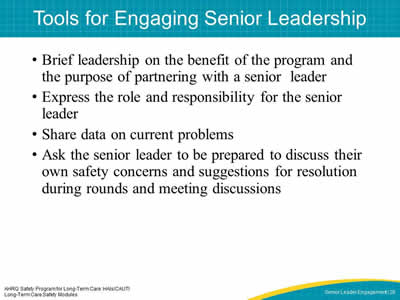
Say:
The first step in working with a senior leader should be to discuss information specific to the facility before he or she initiates safety rounds. In preparation for this meeting, teams should gather relevant information about the facility such as infection rate data, stories of recent near-misses, or instances of harm. Team leads should also brief the senior leader on the structure of the facility safety team and on any safety issues that staff members have raised formally or informally. In turn, team leads should also prepare staff by explaining the purpose of the executive rounds and asking them to be open and ready to discuss their own safety concerns and suggested solutions.
During these safety rounds, the safety team, senior leader, and facility staff should review any documented safety issues and note them on a tracking log.
Slide 27: Action Plan for Engaging Senior Leader
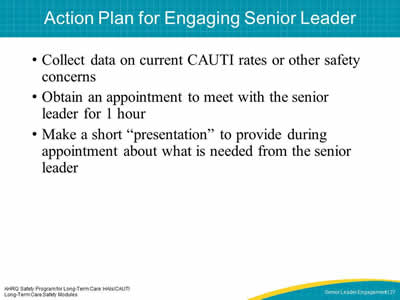
Say:
Engaged senior leadership is crucial for the success and sustainability of any initiative. The following provides an action plan for approaching a senior leader to get them on board.
Slide 28: Exercise
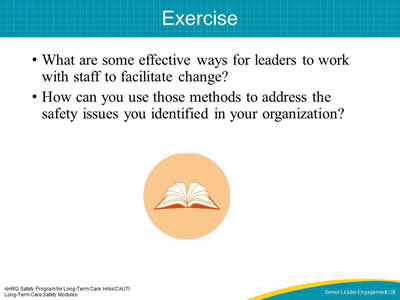
Ask:
What are some effective ways for leaders in your facility to work with staff to facilitate change? How can you use those methods to address the safety issues you identified in your organization?
Slide 29: Key Concepts Review
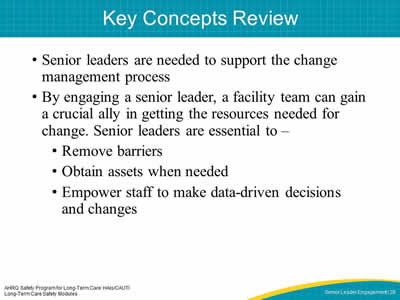
Say:
While facility teams and facility-level managers can easily meet to discuss potential threats to safety, without the buy-in and full engagement of senior leadership, it will be difficult to secure the resources and accountability often required to implement system changes.
Slide 30: References
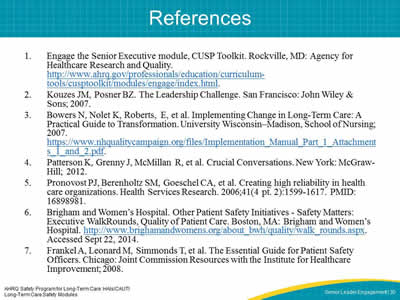
- Engage the Senior Executive module, CUSP Toolkit. Rockville, MD: Agency for Healthcare Research and Quality.
- Kouzes JM, Posner BZ. The Leadership Challenge. San Francisco: John Wiley & Sons; 2007.
- Bowers N, Nolet K, Roberts, E, et al. Implementing Change in Long-Term Care: A Practical Guide to Transformation. University Wisconsin–Madison, School of Nursing; 2007.
- Patterson K, Grenny J, McMillan R, et al. Crucial Conversations. New York: McGraw-Hill; 2012.
- Pronovost PJ, Berenholtz SM, Goeschel CA, et al. Creating high reliability in health care organizations. Health Services Research. 2006;41(4 pt. 2):1599-1617. PMID: 16898981.
- Brigham and Women's Hospital. Other Patient Safety Initiatives - Safety Matters: Executive WalkRounds, Quality of Patient Care. Boston, MA: Brigham and Women's Hospital. Accessed Sept 22, 2014.
- Frankel A, Leonard M, Simmonds T, et al. The Essential Guide for Patient Safety Officers. Chicago: Joint Commission Resources with the Institute for Healthcare Improvement; 2008.



